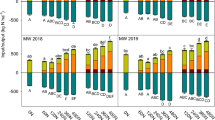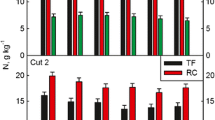Summary
Most studies of N relationships in grassland have used cut swards. These have shown that for annual inputs of 200 to 400 kg N/ha from fertilizer or fixation, 55 to 80% of the N is recovered in harvested herbage. Generally, no more than 5 to 15% is lost through leaching and denitrification with most of the remaining N incorporated into soil organic matter. The relatively high efficiency of N use by cut swards reflects rapid uptake of N and the removal of a large part of the input in herbage. Inclusion of the grazing ruminant alters the efficiency of N use; only 5–20% of the input is recovered in meat or milk, and 75 to 90% of the N ingested is excreted, mainly as urea in urine. Application of N in urine ranges from 30–100 g/m2. Too much N is voided for effective recovery by the sward whilst soils usually contain insufficient C to allow appreciable immobilization. The surfeit is lost. Hydrolysis of urea is usually complete within 24 h of urine deposition. For urine-treated pasture in New Zealand (NZ) losses by NH3 volatilization of up to 66% of applied N are found during warm dry weather, with an average of 28% for a range of seasonal conditions. In the UK, the average rate of NH3 loss from an intensively grazed ryegrass sward was 0.75 kg N/ha/day during a 6-month season. NH +4 remaining in the soil may be nitrified, nitrification being complete within 3 to 6 weeks. Although some NO −3 is recovered by plants, a substantial portion is leached and/or denitrified. On average such losses were 42%, with only 30% of the added N recovered by plants in urine-treated pasture in NZ. In the UK annual leaching of 150 to 190 kg N/ha has been observed for grazed swards receiving 420 kg N/ha/yr. Low retention of N by grazing ruminants results in a breakdown of N relationships in intensively managed grasslands. The substantial losses through NH3 volatilization, leaching and denitrification have serious agronomic, economic and environmental implications.
Similar content being viewed by others
References
Back H L 1962 The loss of ammonia to the atmosphere from urine deposited on pasture. The Grassland Research Institute, Annual Report No 14, p 42
Ball P R 1979 Nitrogen relationships in grazed and cut grass-clover systems. Ph.D. Thesis, massey University, 217 p.
Ball P R 1982 Nitrogen balances in intensively managed pasture systems.In Nitrogen balances in New Zealand ecosystems. Ed. P W Gandar, pp 47–66. D.S.I.R., Palmerston North.
Ball P R and Keeney D R 1983 Nitrogen losses from urine-affected areas of a New Zealand pasture, under contrasting seasonal conditions. Proc. XIV Int. Grassl. Cong. (Lexington), 342–344.
Ball P R, Keeney D R, Theobald P W and Nes P 1979 Nitrogen balance in urine-affected areas of a New Zealand pasture. Agron. J. 71, 309–314.
Clement C R and Williams T E 1967 Leys and soil organic matter. II. The accumulation of nitrogen in soils under different leys. J. Agric. Sci., Camb. 69, 133–138.
Cowling D W 1982 Biological nitrogen fixation and grassland production in the United Kingdom. Phil. Trans. Royal Scoc. Lond. B296, 397–404.
Crush J R, Cosgrove G P and Brougham R W 1983 Nitrogen fixation during 1979–81 in two pastures on the Manawatu Plains. N.Z.J. Exp. Agric. 11, 17–20.
Denmead O T, Simpson J R and Freney J R 1974 Ammonia flux into the atmosphere from a grazed pasture. Science 185, 609–610.
Denmead O T, Simpson J R and Freney J R 1977 Direct field measurement of ammonia emission after injection of anhydrous ammonia. Soil Sci. Soc. Am. J. 41, 1001–1004.
Dowdell R J and Webster C P 1980 A lysimeter study using nitrogen-15 on the uptake fo fertilizer nitrogen by perennial ryegrass swards and losses by leaching. J. Soil Sci. 31, 65–76.
Dowdell R J, Morrison J and Hood A E M 1980 The fate of fertilizer nitrogen applied to grassland: uptake by plants immobilization into soil organic matter and losses by leaching and denitrification.In Prins W H and Arnold G H (eds). The Role of Nitrogen in Intensive Grassland Production. pp 129–136. PUDOC, Wageningen.
Field T R O and Ball P R 1982 Nitrogen balance in an intensively utilised dairy farm system. Proc. N. Z. Grassl. Ass. 43, 64–69.
Forbes T J, Dibb C, Green J O, Hopkins A and Peel S 1980 Factors affecting the productivity of permanent grassland. A national farm study. The Grassland Research Institute, Hurley, 141 p.
Gandar P W 1982 Nitrogen balances in New Zealand ecosystems. D.S.I.R., Palmerston North, 262 p.
Garwood E A and Tyson K C 1977 High loss of nitrogen in drainage from soil under grass following a prolonged period of low rainfall. J. Agric. Sci., Camb. 89, 767–768.
Garwood E A, Tyson K C and Clement C R 1977 A comparison of yield and soil conditions during 20 years of grazed grass and arable cropping. Tech. Rep. 21. The Grassland Research Institute, Hurley. 89 p.
Garwood E A, Salette J and Lemaire G 1980 The influence of water supply to grass on the response to fertilizer nitrogen and nitrogen recovery.In The Role of Nitrogen in Intensive Grassland Production. Eds. W H Prims and G H Arnold. pp 59–65. PUDOC, Wageningen.
Henzell E F and Ross P J 1973 The nitrogen cycle of pasture ecosystems.In Chemistry and Biochemistry of Herbage. Eds., G W Butler and R W Bailey. 2, 227–246.
Horne B 1980 Soil, water and fertilizers. Great House Experimental Husbandry Farm Annual Review 1980 pp 21–26. Min. Ag. Fisheries and Food, London.
Hoglund J H, Crush J R, Brock J L, Ball P R and Carran R A 1979 Nitrogen fixation in pasture XII. General discussion N.Z. J. Exp. Agric. 7, 45–51
Jackman R H 1964 Accumulation of organic matter in some New Zealand Soils under permanent pasture. I & II. N.Z. J. Agric. Res. 7, 445–479.
Keuning J A 1980 Urine scorch in grassland.In The Role of Nitrogen in Intensive Grassland Production. Eds. W H Prins and G H Arnold. p. 163. PUDOC, Wageningen.
Kissel D E and Smith S J 1978 Fate of fertilizer nitrate applied to coastal Bermuda grass on a swelling clay soil. Soil Sci. Soc. Am. J. 42, 77–80.
Lazenby A 1983 Nitrogen relationships in grassland ecosystems. Proc. XIV Int. Grassl. Cong. (Lexington), 56–63.
MacDiarmid B N and Watkin B R 1972 The cattle dung patch. II. Effect of a dung patch on the chemical status of the soil and ammonia nitrogen losses from the patch. J. Br. Grassl. Soc. 27, 43–48.
Morrison J, Jackson M V and Sparrow P E 1980 The response of perennial ryegrass to fertilizer nitrogen in relation to climate and soil. Report of Joint ADAS/GRI Grassland Manuring Trial-GM 20. Tech. Rep. 27, The Grassland Research Institute, Hurley, 95 p.
Ryden J C 1983 Denitrification loss from a grassland soil in the field receiving different rates of nitrogen as ammonium nitrate. J. Soil Sci. 34, 355–366.
Ryden J C 1983 Gaseous nitrogen losses from grassland soils. The Grassland Research Institute Annual Report 1982 (in press).
Ryden J C and Dawson K P 1972 Evaluation of the acetylene-inhibition technique for the measurement of denitrification in grassland soils. J. Sci. Food Agric. 33, 1197–1206.
Smith R V 1976 Nutrient budged on the River Main, Co. Antrim.In Agriculture and water quality M.A.F.F. Tech. Bull. 32, 315–339. H.M.S.O., London.
Steele K W and Shannon P 1982 Concepts relating to the nitrogen economy of a Northland intensive beef farm.In P W Gandar (ed.) Nitrogen Balances in New Zealand ecosystems. Ed. P W Gandar. pp 85–90. D.S.I.R., Palmerston North.
Stewart W D P and Rosswall T 1982 The Nitrogen Cycle. Royal Society, London, 274 p.
Terman G L 1979 Volatilization of nitrogen as ammonia from surface-applied fertilizers, organic amendments and crop residues. Adv. Agron. 31, 189–223.
Vallis I, Harper L A, Catchpoole V R and Weier K L 1982 Volatilization of ammonia from urine patches in a subtropical pasture. Aust. J. Agric. Res. 33, 97–107.
Van der Meer H G 1983 Effective use of nitrogen on grassland farms. Proc. IX Eur. Grassl. Fed. Meeting (Reading),In press.
Whitehead D C 1970 The role of nitrogen in grassland productivity. Commonw. Bur. Pastures and Field Crops Bull. 48, 202 p. Commonw. Agric. Bur., Farnham Royal.
Author information
Authors and Affiliations
Rights and permissions
About this article
Cite this article
Ball, P.R., Ryden, J.C. Nitrogen relationships in intensively managed temperate grasslands. Plant Soil 76, 23–33 (1984). https://doi.org/10.1007/BF02205564
Issue Date:
DOI: https://doi.org/10.1007/BF02205564




